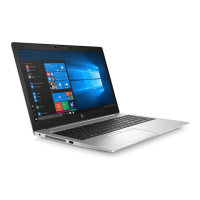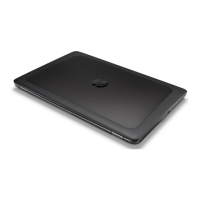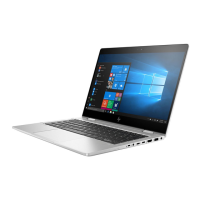
 Loading...
Loading...
Do you have a question about the HP EliteBook 850 G6 and is the answer not in the manual?
| Storage | Up to 2 TB PCIe NVMe SSD |
|---|---|
| Operating System | Windows 10 Pro |
| Processor | 8th Generation Intel Core i5 or i7 processors |
| Display | 15.6-inch diagonal FHD (1920 x 1080) or UHD (3840 x 2160) |
| Memory | Up to 32 GB DDR4-2400 SDRAM |
| Graphics | Intel UHD Graphics or AMD Radeon |
| Battery | 3-cell, 56 Wh Li-ion |
| Ports | 1 HDMI 1.4b, 1 headphone/microphone combo |
| Wireless | Intel Dual Band Wireless-AC 802.11a/b/g/n/ac (2x2) Wi-Fi and Bluetooth Combo |
| Audio | Bang & Olufsen, dual stereo speakers |
| Weight | Starting at 1.78 kg |
Detailed list and descriptions of the computer's hardware components and specifications.
Details the ports and connectors located on the right side of the computer.
Details the ports and features located on the left side of the computer.
Describes the components associated with the display assembly.
Details components within the keyboard area, including touchpad, lights, and special keys.
Identifies and describes the components located on the bottom of the computer.
Identifies and describes the components located on the front of the computer.
Explains the purpose and location of service labels for system identification.
Provides a visual catalog of major computer components with their spare part numbers.
Guidelines for preventing damage to sensitive electronic components from static electricity.
Step-by-step instructions for removing and replacing the computer's bottom cover.
Procedure for safely removing and installing the computer's battery.
Detailed steps for removing and installing the main system board.
Explains system validation error codes indicated by front panel LEDs and audible beeps.
Instructions for downloading and installing BIOS updates from the HP website.
Information on configuring Trusted Platform Module (TPM) settings within the computer's BIOS.
Guide to running diagnostic tests for hardware issues using Windows or UEFI.
Instructions on using Windows tools to back up personal data and create restore points.
Steps to create HP recovery media using the HP Cloud Recovery Download Tool.
Provides detailed technical specifications for the computer's dimensions, weight, and operating conditions.
Specifies general requirements for power cord sets applicable to all countries.
Explains the purpose and usage of different types of nonvolatile memory in the computer.
Information and guidance on recycling electronic hardware, cartridges, and rechargeable batteries.











